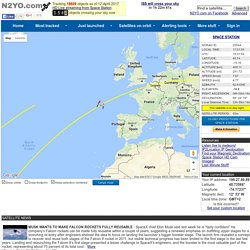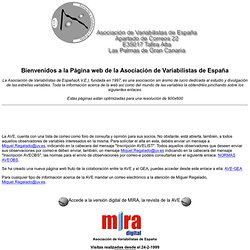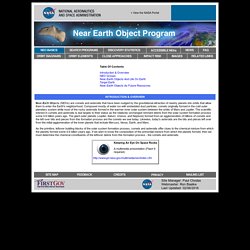

Iaco.es. ISS (ZARYA) MUSK WANTS TO MAKE FALCON ROCKETS FULLY REUSABLE - SpaceX chief Elon Musk said last week he is “fairly confident” his company’s Falcon rockets can be made fully reusable within a couple of years, suggesting a renewed emphasis on outfitting upper stages for a scorching re-entry after engineers shelved the idea to focus on landing the launcher’s bigger booster stage.

The launch firm revealed a concept to recover and reuse both stages of the Falcon 9 rocket in 2011, but visible technical progress has been limited to the first stage in the last few years. Landing and relaunching the Falcon 9’s first stage presented a lesser challenge to SpaceX’s engineers, and the booster is the most valuable part of the rocket, representing about 70 percent of its total cost. More (Source: SpaceFlight Now - Apr 12) Heavens-Above Home Page. LIADAweb. Disculpe!

Informamos a Usted que el Sitio actual de Internet de la LIADA es: Lo esperamos allí para que nos conozca...y nosotros a Usted! Semper observandum...! Estamos en Argentina, Bolivia, Brasil, Chile, Colombia, Costa Rica, Cuba,Ecuador, El Salvador, Guatemala, Honduras, México, Nicaragua, Panamá,Perú, Paraguay, República Dominicana, Uruguay, Venezuela, España yPortugal Somos LIADALiga Iberoamericana de Astronomía Tributo al astrónomo Hans Salm Por Pável Balderas Espinoza Asociación Boliviana de Astronomía (ABA) Cliquear sobre la imágen para leer el homenaje Cliquear sobre el logo para saber ...Que es Pro-Am LIADA? Cliquear sobre el logo para saber...Que es Observatorio X? Cliquear sobre el banner para saber...Qué es el GEFAI?
Reunión de Miembros en la Sede Social El Domingo 19 de Junio se reunieron la ExpoEspacio del CODE, los Miembros de la LIADA Prof. Prof. También se trataron diversos tópicos sobre el funcionamiento exitoso de diversas Secciones de la Institución. vive la LIADA en su conjunto. El cielo del mes.
SkyServer DR7. ASOCIACIÓN DE VARIABILISTAS DE ESPAÑA. Bienvenidos a la Página web de la Asociación de Variabilistas de España La Asociación de Variabilistas de España(A.V.E.), fundada en 1997, es una asociación sin ánimo de lucro dedicada al estudio y divulgación de las estrellas variables.

Toda la información acerca de la web así como del mundo de las variables la obtendréis pinchando sobre los siguientes enlaces. Estas páginas están optimizadas para una resolución de 800x600 La AVE, cuenta con una lista de correo como foro de consulta y opinión para sus socios.
Exoplanet Orbit Database. Catching the Light: Astrophotography by Jerry Lodriguss. Astronomos.org. Astronomia ESP. Astronomía Educativa. Página Principal - SondasEspaciales.com. Destino: Aeolis Mons.

Atravesando la duna Va ya más medio año de avance de Curiosity hacia Aeolis Mons. Es un viaje largo en el que recorrerá más de 8 kilómetros y completará 5 paradas científicas con las que caracterizar diferentes zonas del cráter Gale. Galaxy Zoo: Hubble. Zooniverse - Real Science Online. Diagrama Hertzsprung-Russell. Diagrama Hertzsprung-Russell.
Astronomia - Espacio Profundo.
Advanced Composition Explorer (ACE) Home Page. Advanced Composition Explorer (ACE) Meetings/Workshops Latest 4-day Browse Plot ACE in the News Mission Overview | Science Center | Public Outreach | Science News | Publications | Online DataPersonnel | Picture Gallery | Other Links | ACE Guest Investigators.

International Space Station. Near Earth Objects. Near-Earth Objects (NEOs) are comets and asteroids that have been nudged by the gravitational attraction of nearby planets into orbits that allow them to enter the Earth's neighborhood.

Composed mostly of water ice with embedded dust particles, comets originally formed in the cold outer planetary system while most of the rocky asteroids formed in the warmer inner solar system between the orbits of Mars and Jupiter. The scientific interest in comets and asteroids is due largely to their status as the relatively unchanged remnant debris from the solar system formation process some 4.6 billion years ago. The giant outer planets (Jupiter, Saturn, Uranus, and Neptune) formed from an agglomeration of billions of comets and the left over bits and pieces from this formation process are the comets we see today. Likewise, today's asteroids are the bits and pieces left over from the initial agglomeration of the inner planets that include Mercury, Venus, Earth, and Mars.